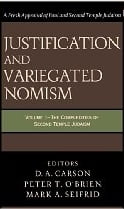In reading Roland Deines’ essay in Second Temple Judaism (“The Pharisees Between ‘Judaisms’ and ‘Common Judaism’”), I came across the following, astute paragraph:
If it is correct that it was particularly halakah that constituted Pharisees as Pharisees, it is also true that it constituted Essenes as Essenes and Sadducees as Sadducees. The same can be said regarding the other Jewish groups that existed prior to 70. This explains why the differences and even antagonism between these three basic movements (which included diverse elements within themselves) did not lead to the complete suspension of religious association within Judaism, whereas the association with early Christians broke off quite soon. All three Jewish movements oriented themselves basically around the Torah as the center of individual and national Jewish existence. In this system the Messiah was subordinated to Torah. For Christians, on the other hand, Christ became the center of individual as well as communal existence. In him, a person’s profound relationship with his own nation was expanded to an eschatological and thus at the same time universal horizon. The final breakdown came when the soteriological marginality of the Torah in relation to Christ could no longer be overlooked in the course of generational change. Even where Torah was observed with sincerity in Jewish-Christian congregations, it had still lost its absolute, eschatological dimension. It had, even in these congregations, reached its τέλος in Christ ( 499–500; italics added).
In this post:[caption id=“attachment_1423” align=“alignleft” width=“80” caption=“D. A. Carson, Peter O’Brien, and Mark Seifrid”]  [/caption]
[/caption]